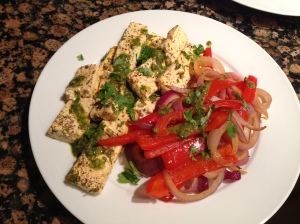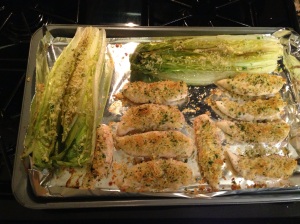This post is more about an idea than a recipe. I don’t have any exact ingredients or measurements for you today. Instead, this post is about experimenting and finding out what works for you.
Last winter, Bobby and I got on a roasted vegetable kick. We were literally roasting vegetables almost daily and then using them in different ways. These tacos were my idea, and they turned out great! We hadn’t made them in a while, so we gave them another shot last night. We used different produce from the first time we made these so the taste was not quite the same, but the result was just as satisfying.
To me, there are few things as delicious as roasted vegetables. I could eat a plate of rich, caramelized vegetables for dinner and be a happy camper. Basically, that’s what you’re doing here, with the added benefit of toppings and a tortilla.
Here’s what we do to make these tacos:
- We go to the store and select produce. We buy what looks good and obviously what’s available. For example, last February (see picture below), we used zucchini. Last night, there was no zucchini to be found at Mariano’s. We did find yellow squash, but it was quite expensive so we scrapped the zucchini/squash idea entirely. We subbed in Chinese eggplant instead. We also buy tortillas and toppings.
- We cut the produce, if necessary. Usually, we buy pre-cut portabella mushrooms, but you could buy whole mushrooms and cut them yourself. The smaller you cut the vegetable, the less time it will take to roast. But don’t go too small because the vegetables will easily burn. Aim for bite-size pieces. Also, I’m sure it goes without saying, but try to cut each type of vegetable uniformly. All mushrooms should be generally the same size, all zucchini should be generally the same size, and so on.
- We decide which vegetables we want to roast together on the same pan and put them in a bowl. We make this decision based on how long it takes to roast them. Last year, I purchased The Roasted Vegetable (find the cookbook here on Amazon), and it includes a table of roasting times and temperatures for various vegetables. Last night, I roasted onion, corn, and mushrooms on one pan, and both the Brussels Sprouts and Chinese eggplant on separate pans.
- We combine the vegetables with olive oil, salt, and pepper. I’ve stopped measuring out the olive oil when I do this step, but be sure not to saturate the vegetables. You want them lightly coated. Although olive oil contains healthy fats, you don’t want to go overboard.
- We spread the vegetables in a SINGLE LAYER on a baking sheet or other cooking vessel. If you want your vegetables to get nice and brown, they cannot be too crowded in the pan. As such, the single layer is very important. If you have too many vegetables, spread them out over various pans or roast in batches. I’ve used baking pans, lasagna pans, Pyrex dishes, etc.
- We roast! Last night, we ended up roasting all our vegetables at 450 degrees for 30 minutes. We had not anticipated that they would all take the same amount of time. The Roasted Vegetable recommended 20-25 minutes for the eggplant, but they weren’t done after 20 minutes.
- We top our tacos. Sometimes we toast our tortillas first, but last night we skipped this step because we were quite hungry. Instead, we put them in the microwave for 15 seconds. Here is how I created my taco: 1) I spread a big dollop of plain, zero percent fat Greek yogurt on the tortilla; 2) I spread a heaping spoonful of veggies on the tortilla; and 3) I covered the veggies with crumbled goat cheese, a couple slices of avocado, and a squirt of Sriracha.
- We enjoy! After two of these tacos, I feel super fulfilled.
Here are a couple pictures of my tacos. Be sure to click on them for a better look!
These are the tacos I made last February. Roasted vegetables: yellow onion, asparagus, Brussels sprouts, zucchini, portabella mushrooms. Toppings: sour cream, queso fresco, toasted pumpkin seeds, Sriracha.
These are the tacos I made for lunch today. (Sorry for the orientation problem; WordPress seems not to want this picture to be horizontal.) Roasted vegetables: red onion, Brussels sprouts, portabella mushrooms, Chinese eggplant, corn. Toppings: Greek yogurt, toasted pumpkin seeds, Sriracha, avocado. I forgot the goat cheese today, but they were still tasty.
Enjoy!









